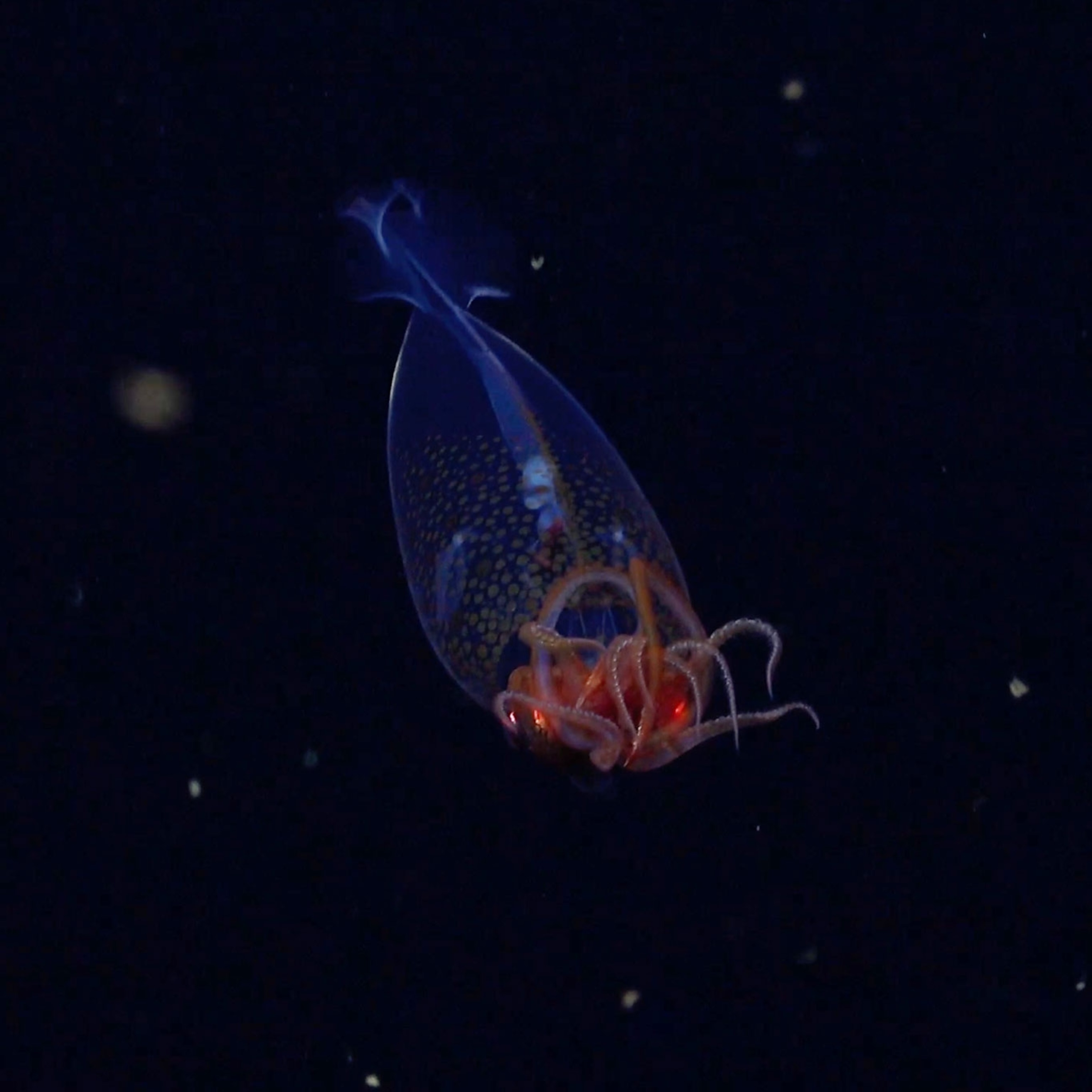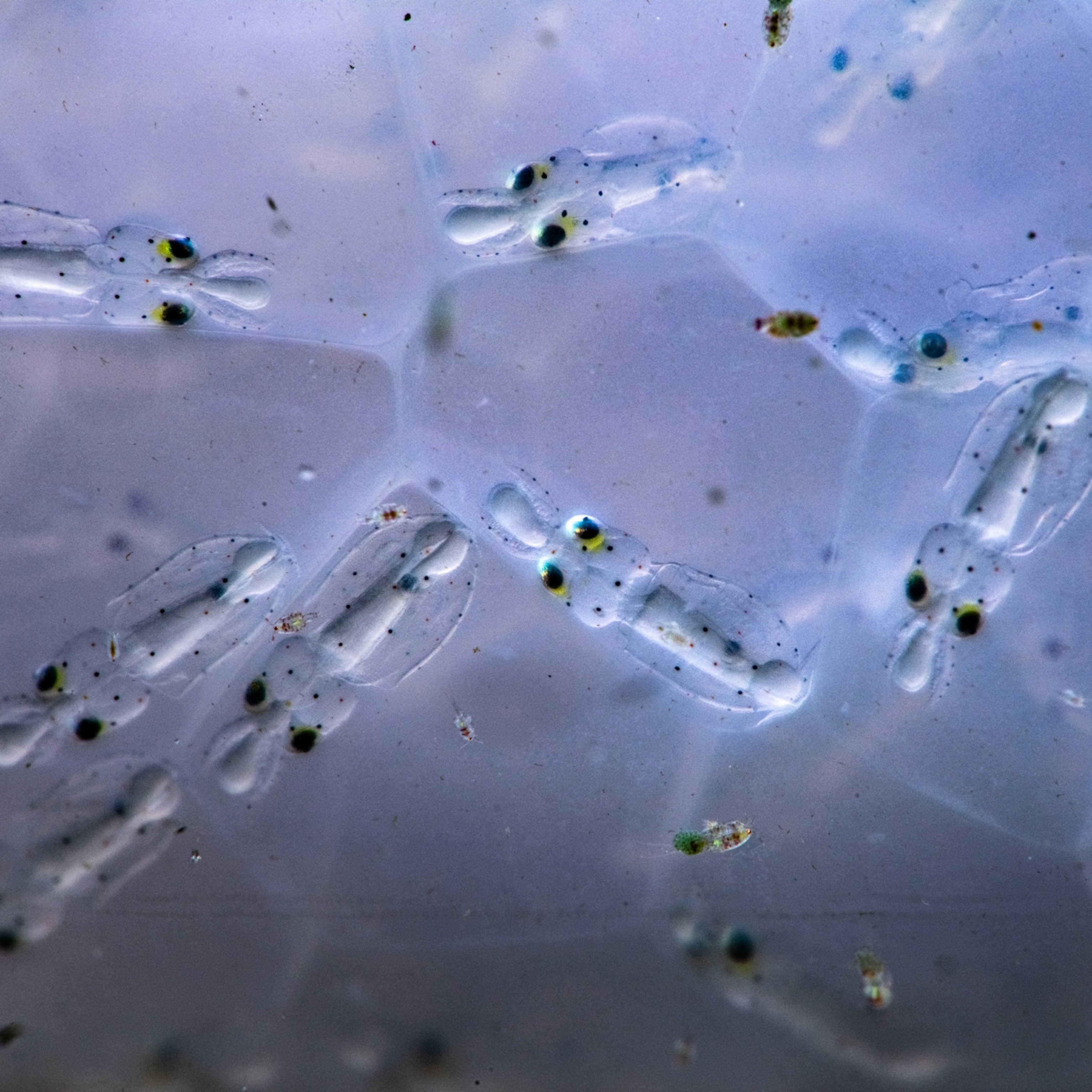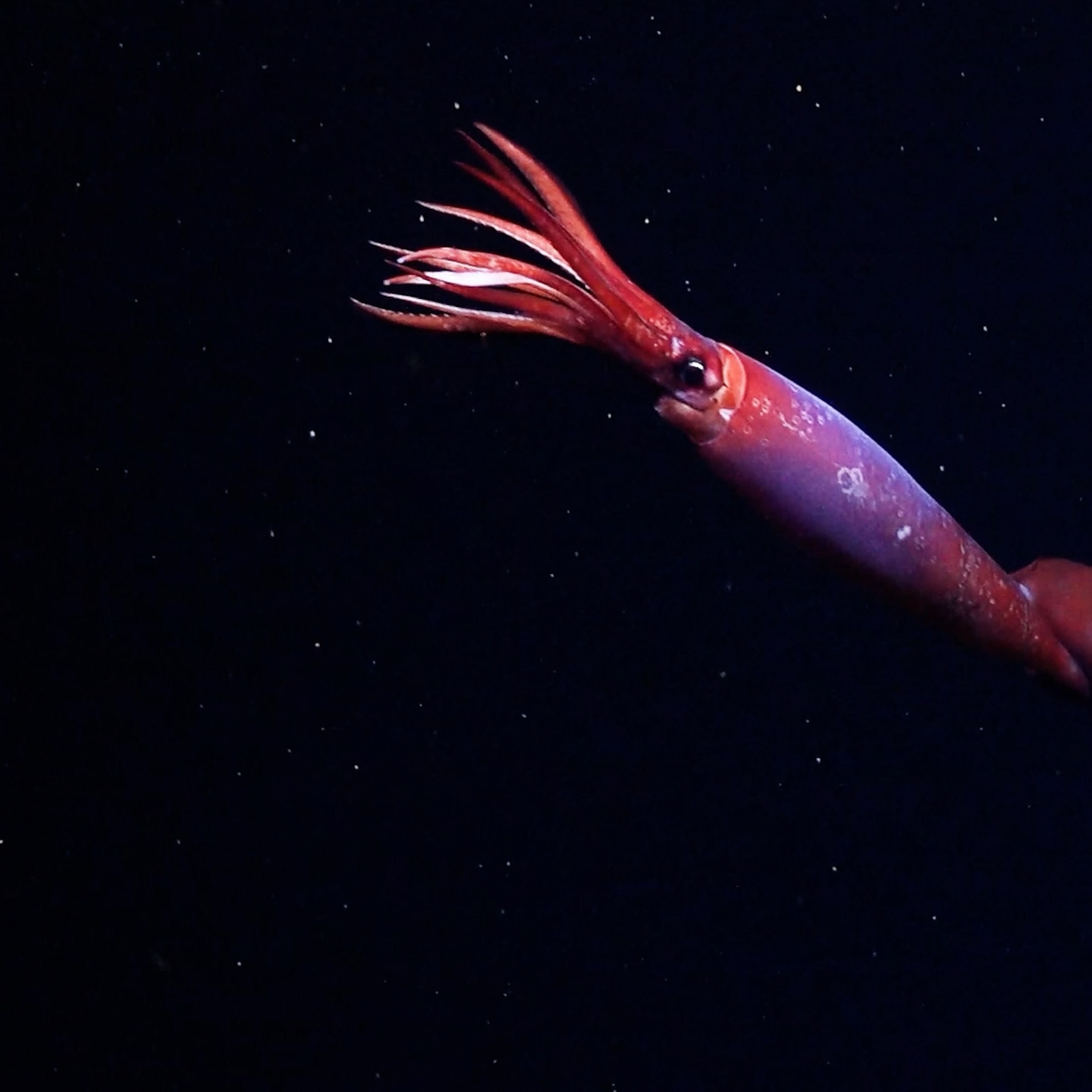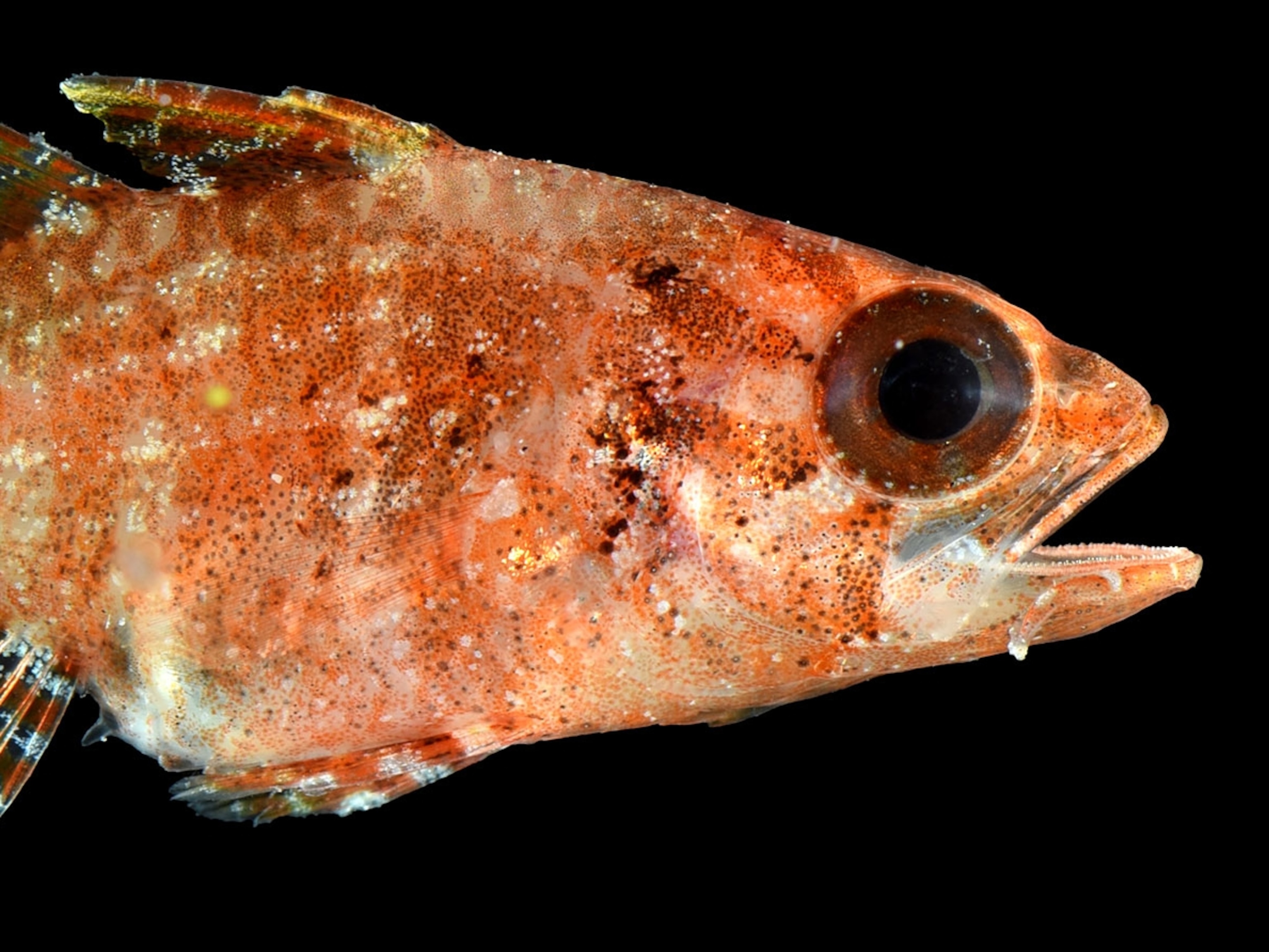
Jumbo Squid Flash, Flail in First Ever Squid-cam Video
Squid also shatter Kevlar plates; might have world's strongest bite.
The first ever video of jumbo squid acting naturally—footage captured by squid themselves—shows the cannibalistic predators lighting up "like Christmas trees," according to a new documentary of a 2009 expedition.
The same expedition established the jumbo squid—one of which shattered two Kevlar bite plates with its beak—as having among the world's strongest bites.
In partially sunlit depths of the Gulf of California, or Sea of Cortez (see map), the camera recorded footage of the squid "strobing" red and white and flailing its arms—signals that could advertise anything from aggression to sexual prowess, according to scientists. (See squid pictures.)
Such behaviors have been seen before in the difficult-to-study species but never without the distractions of divers, lights, and submersibles—and never so close up, said herpetologist Brady Barr, part of the team that captured the footage in September 2009 for the National Geographic Channel show Dangerous Encounters With Brady Barr: Cannibal Squid, airing Friday at 9 p.m. ET/PT. (The National Geographic Society part-owns the National Geographic Channel and wholly owns National Geographic News.)
(See "Alien-like Squid With 'Elbows' Filmed at Drilling Site.")
Barr said the film's objective—"to get an untethered camera on the squid and hope that the animal would return to the abyss and carry on with its way of life," was met, and more.
Known to prey on their own kind, jumbo squid—also called Humboldt squid—can travel to depths of about 4,900 feet (1,500 meters), though most of the filming occurred at depths of less than 330 feet (100 meters).
"I've worked with animals for 20 years," Barr added, "and this was as good as it gets."
Flashy Jumbo Squid Resembles "Christmas Tree"
To get the video, scientists first had to lure several seven-foot-long (two-meter-long) squid—to the surface with bait. (Learn about the related giant squid.)
On three occasions Barr and colleagues got into the water and wrestled different rubbery squid into a synthetic sleeve outfitted with a Crittercam, a National Geographic Society-patented research tool for collecting video, audio, and environmental data.
The first released jumbo squid had red LED lights attached to its camera. When the squid dove deeper, other squid attacked it, perhaps because "squid appear to be able see red LED lights, and it may really piss them off," according to jumbo squid expert William Gilly, who participated in the Cannibal Squid expedition. Torn off by the attackers, the Crittercam surfaced prematurely.
For the second deployment, the team attached a camera without lights to another jumbo squid. When this Crittercam squid entered a jumbo squid swarm at around 140 feet (42 meters), the Crittercam squid began alternately flashing red and white and flaring its tentacles.
"Their entire body flashes—this thing lights up like a Christmas tree," Barr said.
(Related: "Squid's Built-In Light to Inspire New Gadgets?")
It's known that squid and related species of octopus can change their body colors quickly—often to camouflage themselves.
But "it was nice to see that for the first time without humans," Gilly said.
That's because no one knows how artificial lighting can skew a squid's natural behavior, said Gilly, of Stanford University's Hopkins Marine Station in Pacific Grove, California.
Gilly noted that other squid didn't seem to treat the Crittercam squid unusually—other than the first, light-equipped squid—and that all the camera-equipped squid seemed to swim naturally.
Squid Signals: Aggression or Attraction?
The footage strengthens the idea that squid are communicating via flashing and flaring—though it's hard to say what those mean, Gilly said.
For instance, a squid that opens its arms and flashes red-to-white may be trying to look big and impressive.
(Related: "Colossal Squid a Soft, Sluggish Drifter.")
Then again, such a show could be attractive to a potential mate, Gilly said. "If you're a big, strong squid, you're a good fighter and a good mater."
Flashing in jumbo squid is already well known to scientists, said Roger Hanlon, senior scientist at the Marine Biological Laboratory in Woods Hole, Massachusetts.
It's certain that rapid changes in light patterns are part of antagonistic displays among squids—"all of which have some sort of unambiguous visual signal with which to carry out their displays," said Hanlon, who was not part of the research. Hanlon specializes in the study of chromatophore displays in other species of cephalopods, the class of animals that includes squid, octopus, and cuttlefish.
There aren't many observations published about squid behavior in the wild, added Lou Zeidberg, a squid researcher who works in Gilly's lab but wasn't involved in the project.
But Zeidberg noted that in some studies of other squid species, white seems to be a "seductive" color used by male squid—and in the case of the reef squid, by females, according to the Marine Biological Laboratory's Hanlon—and red has been attributed to combative male-male displays.
For instance, Zeidberg has seen—via remotely operated vehicle—an interaction between a small and a big squid off Monterey, California.
While the small squid hovered in front of the ROV displaying white coloration, a larger squid came into view. The small squid immediately turned red and circled the larger squid while maintaining eye contact, he said.
Jumbo Squid Might Be Planet's Strongest Biter
Though seen as one of the oceans' top predators, the jumbo squid remains little understood, expedition leader Barr said.
But scientists do know "they're powerful, they're smart, they're fast, they've got an arsenal of weapons," he said.
For instance, at the center of their array of eight sucker-lined arms, there's a parrotlike beak powered by a mass of muscles.
To measure the strength of a jumbo squid's bite, the team caught a squid at the surface and inserted a Kevlar pressure plate into its mouth—which the squid promptly bit in half. Kevlar is 20 times stronger than steel, according to the Lawrence Berkeley National Laboratory.
The preliminary reading indicated the jumbo squid had a bite force of more than a thousand pounds (more than 455 kilograms)—stronger than the killer jaws of the hyena, though not quite as strong as a crocodile, according to Barr, who specializes in animal bite forces.
More readings are needed, but "for all we know," the jumbo squid may be "the strongest biter on the planet," he said.
MBL's Hanlon isn't surprised by this brute power: "I am pretty sure [a] large squid could bite well into a human arm—and perhaps even through the bone."
Gilly would know. A captive squid bit the Stanford scientist's arm in June while he was fitting it with a Crittercam—requiring 15 stitches.
"When I saw blood flowing into the cooler in large amounts, I realized it wasn't going as planned," Gilly said.
That squid later disappeared with the Crittercam, providing no useful data on how squid hunt and live in oxygen-free depths—Gilly's next areas of study.
Come September, Gilly plans to outfit more jumbo squid with Crittercams—and maybe even find the one that got away.
"I'm feeling like Ahab to some extent," he quipped. "I gotta go get that sucker."
Video: Excerpt From Cannibal Squid Documentary








